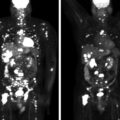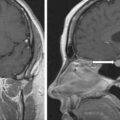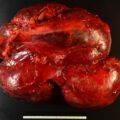Most patients with corticotropin (ACTH)-dependent Cushing syndrome (CS) will have an ACTH-secreting pituitary microadenoma. Approximately 15% of patients with ACTH-dependent CS have an ectopic source of ACTH secretion, with the most common source being a bronchial carcinoid (≈25%). The main clues that a patient may have ectopic ACTH-dependent CS include severe CS as evidenced by spontaneous hypokalemia and 24-hour urinary free cortisol (UFC) >1000 mcg, rapid onset of CS, previous diagnosis of a neuroendocrine tumor, and male sex. Rarely, ectopic ACTH-dependent CS presents with symptoms of mild, long-standing hypercortisolism. Herein we present one such case.
Case Report
The patient was a young 18-year-old woman, a high school student, who presented for evaluation of possible CS. Over the 3 years before the current evaluation, she developed slowly progressive symptoms of weight gain, acne, hirsutism, facial fullness, thinning of hair, and some menstrual irregularity. Diagnosis of polycystic ovarian syndrome was made; however, the patient’s mother was unconvinced and, after performing additional research, requested an evaluation for CS. Eventually, workup for hypercortisolism was pursued and indeed confirmed ACTH-dependent CS ( Table 61.1 ). Magnetic resonance imaging (MRI) of the pituitary gland was then obtained and did not reveal a pituitary adenoma. At that time, the patient presented to our institution.
| Biochemical Test | Result | Reference Range |
| 4 pm serum cortisol, mcg/dL | 16 | 2–14 |
1-mg overnight DST, mcg/dL | 20.8 | <1.8 |
8-mg overnight DST, mcg/dL | 11.8 | <1 |
ACTH, pg/mL | 109 | 7.2–63 |
DHEA-S, mcg/dL | 263 | 44–332 |
24-Hour urine free cortisol, mcg | 158 | <45 |
Midnight salivary cortisol, ng/dL | 458 | <100 |
On physical examination, she demonstrated rounding of the face; acne on face and torso; hirsutism over face, back, and extremities; and violaceous striae on inner thighs.
She was taking no medications. Notably, the patient was under chronic care by a local pulmonologist for chronic bronchitis, and a recent computed tomography (CT) scan of chest demonstrated evidence of mucous plugging.
INVESTIGATIONS
The laboratory test results are shown in Table 61.1 . ACTH-dependent hypercortisolism was documented. A pituitary origin of ACTH was suspected despite a negative MRI of pituitary gland given the mild, long-standing presentation of hypercortisolism. Inferior petrosal sinus sampling was performed to determine the subtype of ACTH-dependent hypercortisolism ( Box 61.1 ) and pointed toward an ectopic source. Given that a CT of the chest was performed locally, the images were obtained and reexamined ( Fig. 61.1 ). On CT, collapse of the right middle lobe was observed, which was interpreted as nonperfused lung related to chronic known infection; also noted were bronchial wall thickening, endobronchial plugging, and clustered micronodularity in the lower lobes. Ga-68 1,4,7,10-tetraazacyclododecane-1,4,7,10-tetraacetic acid (DOTA)-octreotate (DOTATATE) positron emission tomography (PET)-CT imaging was obtained and demonstrated a 1.8-cm neuroendocrine tumor in the right middle lobe (see Fig. 61.1 ).
| ACTH, pg/mL | Cortisol, mcg/dL | ||||
| Right IPS | PV | Left IPS | PV | ||
| −5 minutes | 98 | 63 | 92 | 16 | |
| −1 minute | 85 | 63 | 74 | 16 | |
| +2 minutes | 101 | 70 | 102 | 16 | |
| +5 minutes | 109 | 84 | 95 | 17 | |
| +10 minutes | 110 | 96 | 98 | 18 | |
| +30 minutes | 96 | 16 | |||
| +45 minutes | 94 | 16 | |||
| +60 minutes | 89 | 16 | |||
Stay updated, free articles. Join our Telegram channel

Full access? Get Clinical Tree








